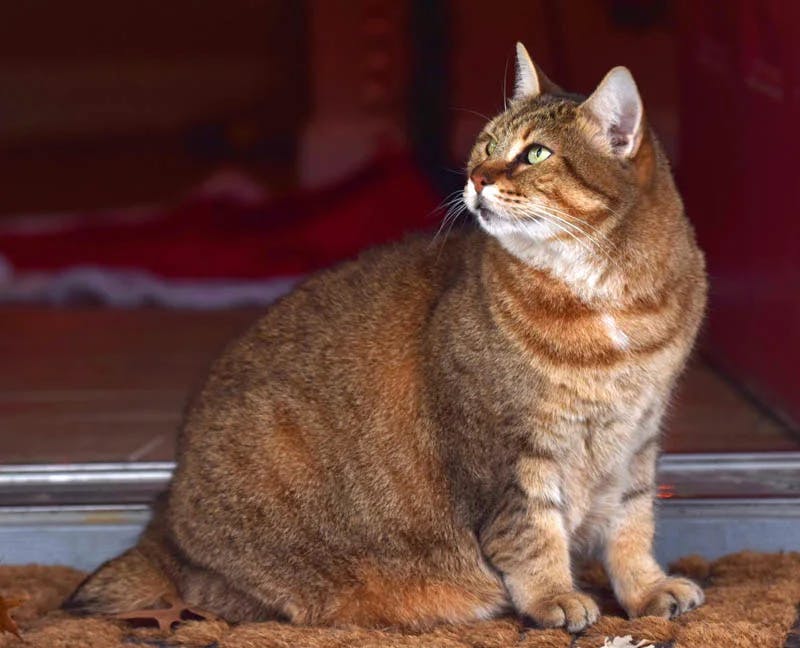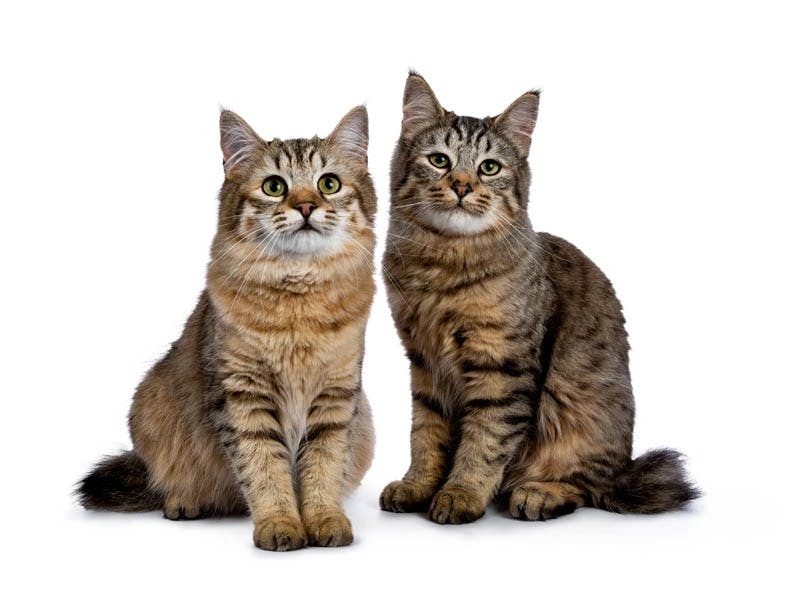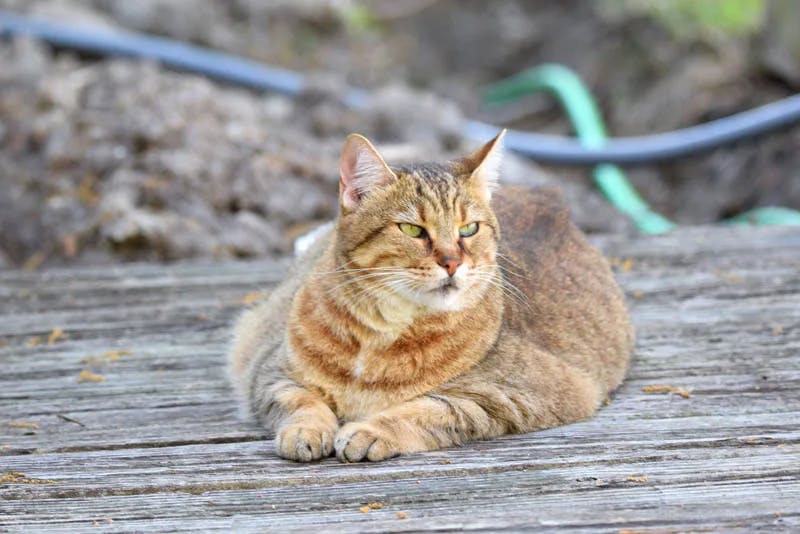Pixie Bob
A Dog-Like Domestic Cat with the Look of a Wild Bobcat
Pixiebob
Antonia Cirjak - Last Updated on December 18th, 2021
Things you Should Know about the Pixiebob
The legend about the origins of the Pixiebob has been intriguing cat breeders for many years.
People believe that they first appeared due to natural matings between feral domestic cats and American bobcats. However, DNA tests do not back it up.
Pixiebob cats are quite large and sturdy, and their look is reminiscent of bobcats. The ownership of these cats is not restricted, and they are considered domestic cats. They are excellent companions, as they are loyal and playful. This makes them popular in any household.

Appearance Matters. What does a Pixiebob look like?
Pixiebob kittens can be born either long-haired and short-haired. These cats have a thick double coat characterized by their wooly texture. When you pet them, you will have a padded feel since their coat projects away from the body.
Long-haired Pixiebobs can have a coat up to two inches long, and its texture is smooth, silky, and soft. They also have lynx tips on their ears, which is similar to wild bobcats. Their facial hair grows downward.
A full-grown Pixiebob will be a brown spotted tabby that will range from tawny to a reddish-brown. It should have small spots, and they are usually muted by heavy ticking. This ticking becomes even heavier during the winter months. They can have golden-brown or gooseberry-green eyes.
The Pixiebob size is medium to large, and they have muscular bodies with prominent bones. Their muscles give them a rolling gait, which makes them resemble a wild cat. They have long, heavy legs, and their hind legs are a bit longer than the front ones. They also have big paws with long and thick toes.
A male Pixiebob will typically weigh between 12lbs and 22lbs, and the females are a bit smaller. They usually weigh between 8lbs and 15lbs.
Their face is similar to wild Bobcats, shaped like an inverted pear with a thick chin. The brows are heavy, and they sit over their medium-sized triangular eyes.
Usually, cats will have five toes on their front paws and four on their back toes. However, Pixiebobs have polydactyl feet. This means that they can have more toes than expected, and these extra toes often show up on their front feet.
Breeder organizations allow Pixiebob cats to have a maximum number of seven toes. They are the only breed that has this allowance.
What colors do the Pixiebob cats come in?
The color of the Pixiebob coat is of a brown tabby pattern. This pattern can be various shades of brown, ranging from light brown to reddish-brown. Some cats also have a bit of silvery and black ticking on their fur.
The tabby markings of a Pixiebob can either be spotted, shaped like rosettes, or come in classic or mackerel patterns. The coats of these cats will normally be black around their paw pads, as well as the tip of their ears and tail.
They also have white fur on their chins and some white coloring around the eyes.
Here are some of the popular colors you can find this breed in:
- Tawny
- Grey
- Red
- Brown
- Light brown
Can a Pixiebob cat have a long tail?
For a Pixiebob to be considered a show-quality cat, it needs to have a minimum tail length of two inches. However, some cats have shorter or longer tails than this.
The original Pixiebob cat had a long tail. Longtails on these cats are normally kinked or knotted, but they can move naturally and quite flexibly.

It's all Personal. The Pixiebob Temperament
Pixiebobs might seem like wild cats on the outside, mostly because they are bred to look that way, but they are regular easy-going household cats. Interestingly, Pixiebobs love water, which makes them somewhat unique in the cat world.
Most people describe Pixiebobs as clever, intelligent cats that bond easily to their family. They are really playful and curious, but they never act destructively. Many compare their personality to that of dogs. You can train them to walk nicely on a leash, and they will love walking next to you.
Make sure to provide them with enough toys and play with them often. These cats need to be mentally stimulated and require exercise. Pixiebobs get along well with other pets and children. They are laid-back, so there should be no problems if you let your kid play with them.
However, you should always teach your children to treat pets with respect. If they mistreat any pet, it will become defensive, and the same goes for the Pixiebob.
Are Pixiebob cats dangerous?
Although Pixiebobs look like wild cats, they are completely domesticated and are not dangerous at all. This breed is people-oriented and will bond with their family. They are friendly and will get along with anyone. You shouldn’t worry about them being dangerous at all.
Caring for your Pixiebob
Short-haired Pixiebobs are more common, and they have a thick, double wooly coat. Long-haired cats have silkier, lighter fur. In both cases, you should brush their coat regularly. This way, you will avoid matting and any excessive shedding.
The base and the tips of their ears have tufts of hair. They also have extra facial hair, similar to a Bobcat. This is something you should pay attention to once they start shedding. However, Pixiebobs are generally low-maintenance cats. You should just make sure that you brush them, clean their ears, and trim their nails once every week.
Pixiebob cats are not a hypoallergenic breed, so be careful around them if you suffer from allergies.

The Health and Happiness of your Pixiebob
The average lifespan of a Pixiebob cat is between 13 and 16 years.
Breeders actively out-cross these cats for better genetic diversity. This is why they don’t have any severe health problems that usually occur with inbreeding. However, they can be prone to the usual diseases and conditions that most domestic cats suffer from.
Hypertrophic cardiomyopathy or heart muscle hardening in one of them. This is a condition that sometimes results in severe cases.
Another problem that may occur at birth is Dystocia. This can make labor extremely painful for Pixiebob cats and can sometimes result in the malformation of the fetus or even the loss of kittens.
Cryptorchidism is another condition these cats can suffer from. It happens when one or both testicles of a male cat do not descend, and they need to be surgically removed.
Next up, there is Cystic endometrial hyperplasia, which makes cysts appear in the cat’s uterus. These cysts end up filled with pus and can become life-threatening unless treated.
How Expensive is a Pixie Bob Cat?
Pixie Bob Cats come in a variety of patterns and believe it or not, these can have an impact on their price. Besides that, the pedigree and the breeder will also determine the final price of your future pet.
In general, Pixie Bob kittens for sale can cost between $500 and $1,500. That is quite a wide ballpark, but within these factors, we’re sure you can find a kitten to your liking.
These cats are large, loyal, and make for excellent pets, so they are definitely worth the price.
Feline History. Where does the Pixiebob come from?
Pixiebobs are believed to have started from an unplanned litter of bobcats and barn cats in 1985. The barn owner where this happened was Carol Ann Brewer, who named a female kitten Pixie. This kitten later became the foundation mother for this breed.
We are not sure if Pixie’s father was actually a wildcat since there is no hard evidence, but most breeders believe it to be true.
The Pixiebob was officially recognized as a breed by The International Cat Association in 1994. The American Cat Fanciers’ Foundation followed suit a bit later, in 2005.
